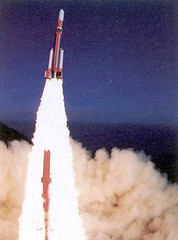
Ginga was Japan's third X-ray astronomy satellite from the JAXA (the Japanese space agency), and the first with United States participation. The satellite launched on February 5, 1987. Science observations continued until Ginga's orbit decayed, bringing it back into the Earth's atmosphere on November 1, 1991.
Ginga's primary science instrument was the Large Area Proportional Counter (LAC), a proportional counter that was designed to study active galaxies and to characterize the time variability in galactic sources such as pulsars. It also carried an All-Sky Monitor (ASM) which could alert astronomers to transient events as well as archive the history of sources in the X-ray sky. Ginga also carried a Gamma-ray Burst Detector (GBD) designed to observe X-rays from gamma-ray bursts, which were a huge mystery in astronomy for over 20 years at the launch of Ginga.
Use the links below or in the sidebar to learn more about Ginga.